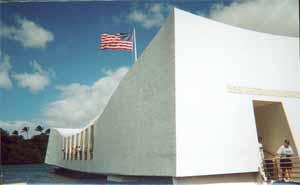Wednesday, March 26, 2025
Pearl
Harbor: A Personal Journey
Part 2: The Battleship You ride in a small boat out to the battleship, most of which is underwater. The top part of the Arizona has been sheared off, and the memorial has been placed on top of it. The memorial is a sort of bridge that contains two rooms and a connecting hallway. The hallway has exhibits in it, including a detailed graphic of the design of the battleship. One of the rooms has flags and paintings in it. The other room has on one wall the names of all 1,178 men who died when the Arizona sank.  Standing there looking at those names, I was filled with an almost overwhelming sadness. I didn't know any of those men, but I could identify with the pain their families must have felt. I looked around and saw a retired Navy chaplain just looking somberly at the wall. Did he know anyone listed there? He probably felt sad all the same. My maternal grandfather fought in the Pacific in World War II. He helped pry the island of Guadalcanal from the Japanese. He saw his best friend get blown to bits while they were trying to carry a boat onto the beach. My grandfather made it out alive, returning home to rear his existing child and have another. He died several years ago, taking with him to his death the terrible, haunting memories of what he saw. He visited Pearl Harbor a few years before he died. He was glad to see the memorial and what it represented: the idea that terrible things should not be forgotten. He never really got over hating the Japanese. He didn't exactly want to hurt Japanese tourists he saw in Hawaii, but he wasn't going out of his way to be friendly to them. He would tell my grandmother, "You didn't see what they did to our boys." I think that's what is most impressive about the Arizona Memorial. Its stark white walls give it the appearance of a tomb, and its wall listing the names of the brave men who died is a constant reminder that even the most innocent of people can be the victims of the most terrible of acts. First page > The Memorial Process > Page 1, 2 |
|
Social Studies for Kids
copyright 2002–2024
David White


